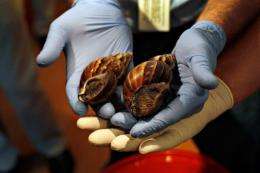'Iron' fist proposed for Miami's giant snail problem

Huge, slimy snails from Africa have overrun a Miami-area town and the US government said Tuesday a potent pesticide is the best way to get rid of their exploding numbers.
Thousands of the four-to-eight inch (10-20 centimeter) giant African snails have been collected in Coral Gables, a town in Miami-Dade County, since the infestation was first discovered in September, said the US Department of Agriculture.
Officials are not sure how or when the exotic snails got to south Florida, but they are hoping to act fast, using the molluscicide iron phosphate to stop to dual-sex creatures from multiplying even faster.
Not only are the giant snails scaring residents, leaving slimy trails and chomping up local cucumber, banana and pumpkin plants, but they also pose a health risk because they carry a dangerous parasite known as the rat lungworm.
If people consume the parasite via contaminated produce or contact with a snail -- and several cases of this have been documented worldwide -- it can enter the central nervous system and cause nausea, headache and nerve damage.
The snails give off a foul odor when they die, and they have been blamed for destroying the whitewashed siding of houses and even causing traffic accidents.
An environmental assessment was issued by the USDA describing the options of doing nothing to kill off the invasive creatures versus applying the pesticide. Public comments are being accepted before a final decision is made.
The proposed remedy is called Sluggo®-AG, which uses wheat gluten to attract slugs and snails and contains 1.0% iron phosphate to poison them.
"After eating the bait, snails stop feeding immediately because the iron phosphate interferes with calcium metabolism in their gut. Snails die three to six days later," said the USDA assessment.
"Hand picking of snails will also be conducted as part of the eradication program. Regular and extensive hand picking is effective in reducing snail numbers when done in combination with other control methods," it added.
The big brown creatures have been found mainly in residential neighborhoods, though the affected area also includes parts of two national parks -- Everglades National Park and the Biscayne National Park.
"Iron phosphate is considered practically non-toxic to humans," the report said, adding that cumulative risks to the environment and other animals are low and the compound is not water soluble so is not likely to pollute groundwater.
The poison pellets would be applied with a spreader, like the kind used to spread grass seed or fertilizer, within a 200 yard (meter) radius of any giant snail sighting.
The entire treatment program, if approved, could go on for two to four years.
The last time giant African snails surfaced in south Florida was in 1966, when a boy smuggled three of them from Hawaii and his grandmother set the snails free in her garden.
They quickly started breeding, and it took almost a decade and a million dollars to get rid of them all.
"Seven years later, more than 18,000 snails had been found. The eradication program took nearly 10 years at a cost of $1 million. Eradication was declared in 1975," the USDA said.
(c) 2011 AFP















